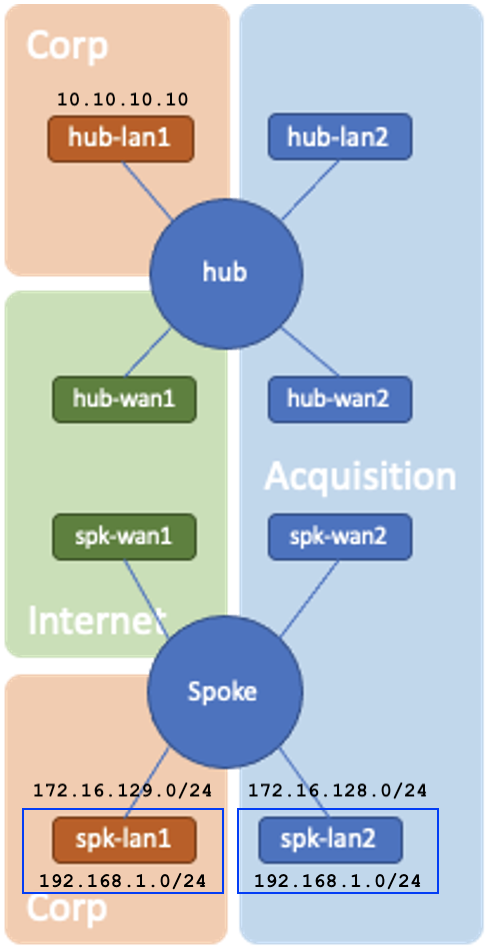Dynamic Ingress Source NAT
Dynamic Source NAT translates multiple source IP addresses into a smaller pool of translated addresses and dynamic ports, which conserves public IP address space and provides the flexibility to source NAT a specific IP range. This supports scaling up sessions for an internal service. For example, in a corporate office with a SIP phone service where all phones have different IPs on port 5060, these internal IP addresses are source NAT’ed to a single external IP address.
Dynamic Source NAT may also provide solutions for IP address conflicts, but the IP mapping is not one-to-one and does NOT provide destination NAT in the reverse direction. To facilitate the destination NAT mapping for network connections from the external client to the internal client, use bidirectional-nat.
Consider the following scenario, similar to the Static NAT example focusing on a company acquisition, where the spk-lan2 network is overlapping and not routable in Corp and Internet.

The Dynamic Source NAT challenge is illustrated in scenarios #2 and #4 below, where multiple clients of IP subnet 192.168.1.0/24, from spk-lan2 are running same application on port 1111, but given only one IP address, 172.16.128.10, to source NAT out.
| Scenario | Source | Destination | Translation Required |
|---|---|---|---|
| 2 | 192.168.1.10:1111 @ spk-lan2 192.168.1.11:1111 @ spk-lan2 | 10.10.10.10:xxxx @ hub-lan1 | 172.16.128.10:1653 -> 10.10.10.10:xxxx 172.16.128.10:1654 -> 10.10.10.10:xxxx |
| 4 | 192.168.1.10:1111 @ spk-lan2 192.168.1.11:1111 @ spk-lan2 | 172.16.129.10:* @spk-lan1 | 172.16.128.10:1653 -> 172.16.129.10:xxxx 172.16.128.10:1654 -> 172.16.129.10:xxxx |
By applying Dynamic Source NAT configuration to the spk-lan2 interface, the 192.168.1.0/24 subnet can be mapped to the single IP address and subnet 172.16.128.10/32, with dynamically allocated ports. This allows the SSR to dynamically build a many-to-one source NAT mapping.
Configuration
In scenario #2, sessions from an application using port 1111 are initiated from multiple clients of the spk-lan2 interface, to a client of hub-lan1 on 10.10.10.10. The first client at host 192.168.1.10 and port 1111 is assigned a source NAT of 172.16.128.10:1653 where port 1653 is allocated dynamically. The second client at 192.168.1.11 with port 1111 is allocated a dynamic source NAT of 172.16.128.10:1654.
Scenario #4 is similar, except the target connections are to the client at the spk-lan1 interface using 172.16.129.10 which has been mapped by Static NAT. The same Dynamic Source NAT processes from Senario #2 are applied here.
The following is the router configuration for both the above use cases. Packets going through spk-lan2 within the 192.168.1.0/24 domain will be source-natted to 172.16.128.10/32.
Sample PCLI Configuration
config
authority
router spoke
node node1-spoke
device-interface spk-lan2
network-interface spk-lan2
dynamic-source-nat 192.168.1.0/24
local-ip 192.168.1.0/24
remote-ip 172.16.128.10/32
exit
exit
exit
exit
exit
exit
exit
Sample GUI Configuration:
Network Interface Configuration

Dynamic Source NAT Configuration

Configuration Commands
Dynamic Source NAT is configured from the network-interface using the following commands:
dynamic-source-nat: Defines the prefixes that need to be dynamically source natted for packets ingressing this interface.
local-ip: For packets ingressing this interface, the IP that is source NAT'ed to theremote-ip.remote-ip: For packets ingressing this interface, the IP where thelocal-ipwill be source NAT'ed.remote-ipmust use the /32 prefix.
Show Commands
The show network-interface source-nat-rules can be run from the router or the conductor to display brief or detailed information for NAT configurations. Please see the NAT Troubleshooting pages for information about the source-nat-rules subcommand.